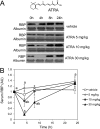Lecithin:retinol acyltransferase is critical for cellular uptake of vitamin A from serum retinol-binding protein
- PMID: 22637576
- PMCID: PMC3397848
- DOI: 10.1074/jbc.M112.353979
Lecithin:retinol acyltransferase is critical for cellular uptake of vitamin A from serum retinol-binding protein
Abstract
Vitamin A (all-trans-retinol) must be adequately distributed within the mammalian body to produce visual chromophore in the eyes and all-trans-retinoic acid in other tissues. Vitamin A is transported in the blood bound to retinol-binding protein (holo-RBP), and its target cells express an RBP receptor encoded by the Stra6 (stimulated by retinoic acid 6) gene. Here we show in mice that cellular uptake of vitamin A from holo-RBP depends on functional coupling of STRA6 with intracellular lecithin:retinol acyltransferase (LRAT). Thus, vitamin A uptake from recombinant holo-RBP exhibited by wild type mice was impaired in Lrat(-/-) mice. We further provide evidence that vitamin A uptake is regulated by all-trans-retinoic acid in non-ocular tissues of mice. When in excess, vitamin A was rapidly taken up and converted to its inert ester form in peripheral tissues, such as lung, whereas in vitamin A deficiency, ocular retinoid uptake was favored. Finally, we show that the drug fenretinide, used clinically to presumably lower blood RBP levels and thus decrease circulating retinol, targets the functional coupling of STRA6 and LRAT to increase cellular vitamin A uptake in peripheral tissues. These studies provide mechanistic insights into how vitamin A is distributed to peripheral tissues in a regulated manner and identify LRAT as a critical component of this process.
Figures










Similar articles
-
Vitamin A Transporters in Visual Function: A Mini Review on Membrane Receptors for Dietary Vitamin A Uptake, Storage, and Transport to the Eye.Nutrients. 2021 Nov 9;13(11):3987. doi: 10.3390/nu13113987. Nutrients. 2021. PMID: 34836244 Free PMC article. Review.
-
The retinol esterifying enzyme LRAT supports cell signaling by retinol-binding protein and its receptor STRA6.FASEB J. 2014 Jan;28(1):26-34. doi: 10.1096/fj.13-234310. Epub 2013 Sep 13. FASEB J. 2014. PMID: 24036882 Free PMC article.
-
STRA6-catalyzed vitamin A influx, efflux, and exchange.J Membr Biol. 2012 Nov;245(11):731-45. doi: 10.1007/s00232-012-9463-1. Epub 2012 Jul 20. J Membr Biol. 2012. PMID: 22815070 Free PMC article.
-
Retinyl ester formation by lecithin: retinol acyltransferase is a key regulator of retinoid homeostasis in mouse embryogenesis.J Biol Chem. 2008 Feb 29;283(9):5611-21. doi: 10.1074/jbc.M708885200. Epub 2007 Dec 19. J Biol Chem. 2008. PMID: 18093970 Free PMC article.
-
Regulation of hepatic retinol metabolism: perspectives from studies on vitamin A status.J Nutr. 2004 Jan;134(1):269S-275S. doi: 10.1093/jn/134.1.269S. J Nutr. 2004. PMID: 14704332 Review.
Cited by
-
Liver retinol transporter and receptor for serum retinol-binding protein (RBP4).J Biol Chem. 2013 Jan 11;288(2):1250-65. doi: 10.1074/jbc.M112.369132. Epub 2012 Oct 26. J Biol Chem. 2013. PMID: 23105095 Free PMC article.
-
Transport of vitamin A across blood-tissue barriers is facilitated by STRA6.FASEB J. 2016 Aug;30(8):2985-95. doi: 10.1096/fj.201600446R. Epub 2016 May 17. FASEB J. 2016. PMID: 27189978 Free PMC article.
-
Vitamin A Transporters in Visual Function: A Mini Review on Membrane Receptors for Dietary Vitamin A Uptake, Storage, and Transport to the Eye.Nutrients. 2021 Nov 9;13(11):3987. doi: 10.3390/nu13113987. Nutrients. 2021. PMID: 34836244 Free PMC article. Review.
-
An alternative retinoic acid-responsive Stra6 promoter regulated in response to retinol deficiency.J Biol Chem. 2015 Feb 13;290(7):4356-66. doi: 10.1074/jbc.M114.613968. Epub 2014 Dec 28. J Biol Chem. 2015. PMID: 25544292 Free PMC article.
-
STRA6 is critical for cellular vitamin A uptake and homeostasis.Hum Mol Genet. 2014 Oct 15;23(20):5402-17. doi: 10.1093/hmg/ddu258. Epub 2014 May 22. Hum Mol Genet. 2014. PMID: 24852372 Free PMC article.
References
-
- Chambon P. (1996) A decade of molecular biology of retinoic acid receptors. FASEB J. 10, 940–954 - PubMed
-
- Paik J., Vogel S., Quadro L., Piantedosi R., Gottesman M., Lai K., Hamberger L., Vieira Mde M., Blaner W. S. (2004) Vitamin A. Overlapping delivery pathways to tissues from the circulation. J. Nutr. 134, 276S–280S - PubMed
Publication types
MeSH terms
Substances
Grants and funding
LinkOut - more resources
Full Text Sources
Medical
Molecular Biology Databases

